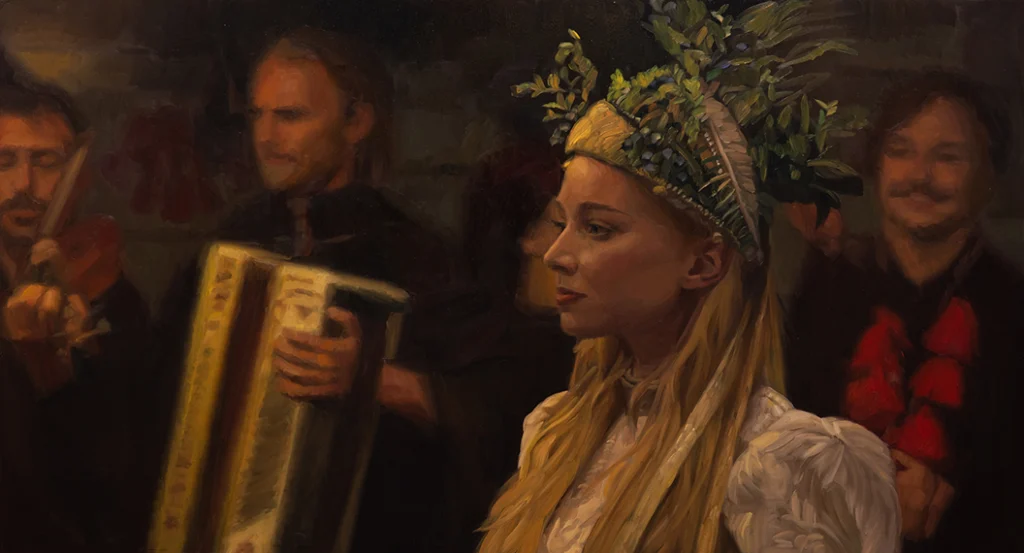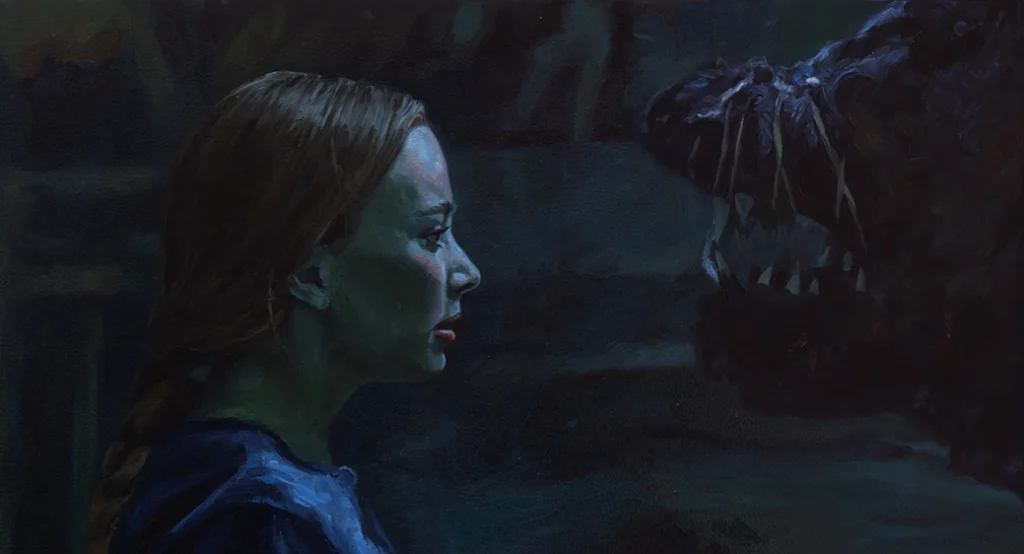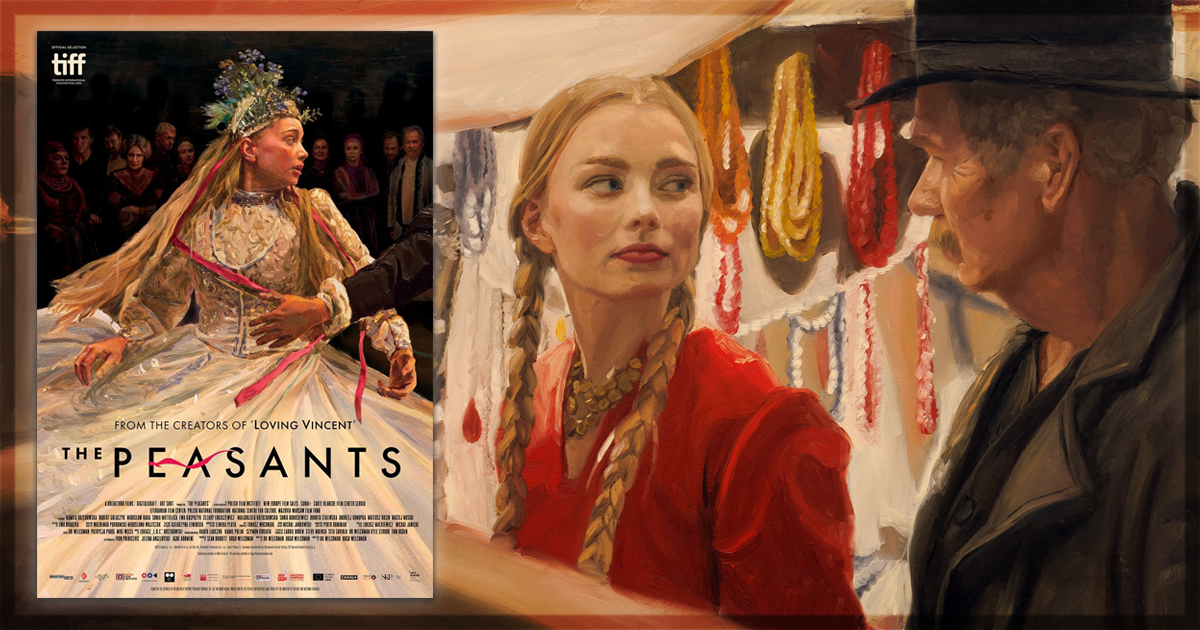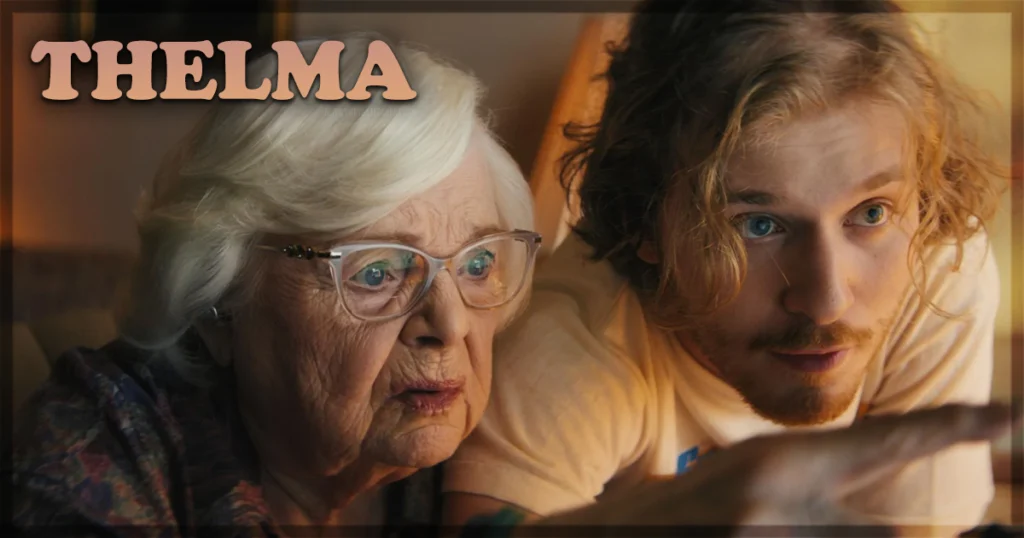When it comes to paintings and art, I’m not a huge connoisseur. I can walk through an art gallery and appreciate most pieces from a technical level, but as far as anything I would purchase and own for my own enjoyment, I’m pretty indifferent to most things. A new animated film distributed by Sony Pictures Classics is The Peasants; it was also the Polish submission to the 96th Annual Academy Awards (aka the Oscars) this year. This breathtaking Polish language film is presented in a real-life, oil-painted animation style; each frame of its nearly two-hour runtime is as gorgeous as most work you could find on display at any art gallery.
It tells the story of a time when, you guessed it, peasants and small villages were the norm, dating into the late 19th century, about a hundred and fifty years ago. The Polish peasants in The Peasants and society in general at the time had a strong patriarchal culture, and women had very little power or control over how their own lives played out.
Despite the fact this film is animated, this is no children’s movie as it as an adult drama and does contain sequences of sex, as well as depictions of rape and nudity. As I mentioned, this movie is as beautiful as it is heartbreaking. Although some may shy away from an adult-themed animated movie, this is an impeccably well-crafted story and film in many aspects. So make the time to catch up with The Peasants when you can, despite its name, this wonderful film is fit for a king.

The story of the movie The Peasants
[There are mild spoilers ahead for The Peasants.]
As The Peasants opens we see a golden field before our eyes. Some archaic music begins to fill our ears, like something you might hear at a renaissance festival or in some other medieval setting. The camera lowers into the field until the animation “camera” comes to rest on a pretty purple flower that after a few moments, does a sort of time lapse forward.
We watch as the flower, like a dandelion, begins to produce the little white seeds known as pappi that float on a breeze. Some winds begin to catch the seeds, we watch as the camera follows some of them and we’re privy to an aerial shot of the lush green and yellow field with some scattered flowers and trees nearby. I will discuss in more detail the actual visual presentation and animation of the film shortly, but needless to say, right from the very outset the beauty of this film captures your attention.
Kamila Urzedowska voices Jagna
The music plays on as the tiny white seeds float across the pathway of a beautiful young blonde woman Jagna (voiced by Kamila Urzedowska) as she walks. She wears a dark blue blouse and hat are that is contrasted with a pumpkin orange skirt. She reaches out, snags one of the tiny seeds in her hand, and then, blows the little white puff away after doing a twirl. It floats up as some birds fly by overhead, the shot follows it a moment as it is carried away. Back at her house above her bed we watch Jagna with her hair out, bright red lips in a white nightgown as she puts a paper cutout on her wall and smooths it with her hands. She is an artist of sorts and makes many beautiful paper designs – she has an artistic flair for making designs with things.
A couple scenes later we observe Jagna at some sort of church service, she begins to slowly turn her head around to the left and after a few moments, her face mostly in view with her eyelashes fluttering, she gazes in the direction of the camera. We see the man she’s looking at, Antek Boryna (Robert Gulaczyk), a stern and smoldering look spread across his broad face, a smirk forms on the corner of his mouth after a moment.
Jagna’s free spirit comes up against societal expectations in The Peasants
Jagna smiles back at him and he shyly looks down and we naturally assume these two are involved in some kind of romance. An outside view of the white church appears and the word Autumn displays onscreen, the film follows us through some seasons in the lives of these characters. After the church service we spend a little time with a few of the townspeople. Jagna’s mother Marcjanna (Ewa Kasprzyk) is chatting with the mayor’s wife and we get the sense that Jagna is a bit of a free spirit, yet the society and the rules governing their people prohibit her from doing what she would like with her own life. She’s expected to fit the mold of what is normally considered from a young woman, to be given away for a dowry to the highest bidder and to be a good housewife.
Although Marcjanna seems to love her daughter, because of her rare beauty, she also views her as a valuable asset, one that can be bartered and traded with for money and or property. But because of Jagna’s looks and because she loves the handsome Antek, the jealous women about town tend to gossip heavily and makeup stories about the philandering nature of the young woman. And once Marcjanna and Antek’s father, the wealthy land owner Maciej Boryna (Miroslaw Baka), meet together and arrange for Jagna to be “sold” to him for a large amount of land, things begin to deteriorate in many of these relationships. Although the film plays up these relationship dynamics and does veer at times into the melodramatic, ultimately, the overarching story and where it all goes offers us a fascinating, if not saddening, tale of love and loss.

The Peasants has a splendor of visuals
The first thing that must be discussed about this film’s technical achievements is the splendor of its visuals. Although, in some ways, it eventually becomes a bit rote in how impressive it all looks, we’re repeatedly reminded that what we’re watching is stunning. From the scenes of the natural beauty to the people, their faces, the village and it’s buildings of brown and gray, the color palette in this film is second to none and every few minutes I kept being reminded of how incredible it all looked. How realistic, lifelike and fluid it all was, was simply stunning.
DK Welchman and Hugh Welchman wrote and directed the film
The husband and wife duo, DK Welchman and Hugh Welchman, who are responsible for the majority of the direction and screenwriting for the film, also directed and wrote the Oscar nominated animated film, Loving Vincent, from a few years ago. When it comes to the writing, The Peasants is not breaking any ground with its story construction, this is a story of love, jealousy, revenge and loss. I wasn’t too engaged by the love story and some of these more mundane aspects of the writing, but what I did find engaging are the nuances of the period piece setting, the way society functioned in some of the remote areas of the countryside and ultimately what becomes of these characters.
This is no Pride & Prejudice or Charlotte Wells caliber story, mind you, but it is a beautiful and unique cinematic experience that I enjoyed, even if I wasn’t hanging on every line of dialogue. This time of year the theatres are getting the bare bones of what the film industry has to offer; I looked up the marquee to my local cinema today and couldn’t find anything I was interested in watching. But if The Peasants happens to be showing near you over the next few weeks, you could do worse than this pretty little foreign film.
Final thoughts on The Peasants
Despite the inexplicable poor rotten tomatoes score, The Peasants is a beautiful film that should appeal to many mainstream audiences and critics alike. Even with a semi-standard story of a woman ostracized by a society of Peasants, this film definitely doesn’t feel poor standing, beautiful, and fair amongst some of the better foreign films of the year.
The Peasants is now playing in select theaters.
What do you think of the oil painting style animation? Does it make The Peasants more interesting to you? Connect with us on X @MoviesWeTexted and let us know.



